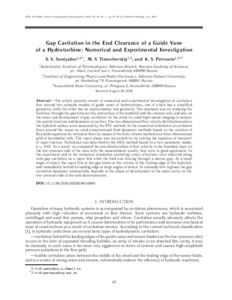Показать сокращенную информацию
Gap Cavitation in the End Clearance of a Guide Vane of a Hydroturbine: Numerical and Experimental Investigation
| Автор | Сентябов, Андрей Васильевич | |
| Автор | Тимошевский, Михаил Викторович | |
| Автор | Первунин, Константин Сергеевич | |
| Дата внесения | 2020-01-20T07:14:50Z | |
| Дата, когда ресурс стал доступен | 2020-01-20T07:14:50Z | |
| Дата публикации | 2019 | |
| Библиографическое описание | Сентябов, Андрей Васильевич. Gap Cavitation in the End Clearance of a Guide Vane of a Hydroturbine: Numerical and Experimental Investigation [Текст] / Андрей Васильевич Сентябов, Михаил Викторович Тимошевский, Константин Сергеевич Первунин // Journal of Engineering Thermophysics. — 2019. — Т. 28 (№ 1). — С. 67-83 | |
| ISSN | 18102328 | |
| URI (для ссылок/цитирований) | http://pleiades.online/ru/journals/search/?lang=ru&type=contents&name=jenther&year=2019&lyear=2019 | |
| URI (для ссылок/цитирований) | https://elib.sfu-kras.ru/handle/2311/128706 | |
| Описание | Текст статьи не публикуется в открытом доступе в соответствии с политикой журнала. | |
| Аннотация | The article presents results of numerical and experimental investigation of cavitation flow around two subscale models of guide vanes of hydroturbines, one of which has a simplified geometry, while the other has an approximately real geometry. The emphasis was on studying the fluid flow through the gap between the end surface of the hydrofoil and the channel wall, and also on the onset and development of gap cavitation. In the study we used high-speed imaging to analyze the spatial structure and dynamics of cavities. The two-dimensional flow velocity distributions above the hydrofoil surface were measured by the PIV method. In the numerical simulation of cavitation flows around the vanes we used computational fluid dynamics methods based on the solution of Reynolds equations for turbulent flows by means of the finite volume method on a three-dimensional grid of hexahedral cells. The vapor phase was accounted for by solving the equation of transport of vapor fraction. Turbulence was described by the DES method based on a two-parameter model, k-ω SST. As a result, we compared the calculated profiles of flow velocity in the boundary layer on the low-pressure side of the vane with the measurement results; they were in good agreement. In the experiment and in the numerical simulation cavitating vortex structures were observed along with gap cavitation as a vapor film while the fluid was flowing through a narrow gap. At a small angle of attack the vapor film in the gap forms in the vicinity of the trailing edge of the hydrofoil, and immediately behind its leading edge at large angles of attack. In unsteady flow regimes the gap cavitation dynamics substantially depends of the phase of development of the main cavity on the low-pressure side of the vane decompression. | |
| Название | Gap Cavitation in the End Clearance of a Guide Vane of a Hydroturbine: Numerical and Experimental Investigation | |
| Тип | Journal Article | |
| Тип | Published Journal Article | |
| Страницы | 67-83 | |
| ГРНТИ | 30.17 | |
| Дата обновления | 2020-01-20T07:14:50Z | |
| DOI | 10.1134/S1810232819010065 | |
| Институт | Институт инженерной физики и радиоэлектроники | |
| Подразделение | Кафедра теплофизики | |
| Журнал | Journal of Engineering Thermophysics | |
| Квартиль журнала в Scopus | Q2 | |
| Квартиль журнала в Web of Science | Q4 |

